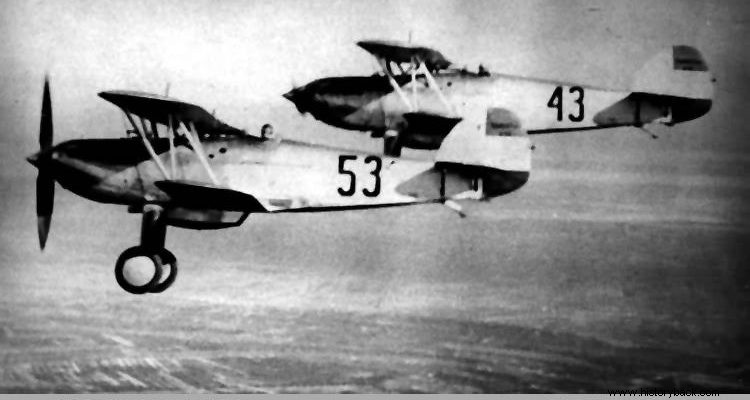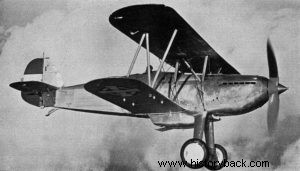
Prior to World War II the Yugoslav Royal Air Force procured around 50 British Hawker Fury I and II biplane fighters. Others were powered by a Rolls Royce Kestrel XVI engine which gave them a top speed of 405 km per hour (x .a.h.) making them the fastest aircraft of the type and others had Hispano-Souiza 12NB engines, which gave them a speed of about 360 h.p.h.
When the German invasion of Yugoslavia took place on April 6, 1941, there was an air regiment, the 5th, which was equipped with Hawker Fury I &II fighters , many of them equipped with two additional machine guns in the wings in addition to the two in the nose.
The 5th Air Pursuit Regiment under Lt. Col. Leonid Banjak had two "battalions" (squadrons), the 35th and 36th, each with 15 Fury IIs. The 35th under Major Zivanovic, had the 109th and 110th "companies" (each with seven aircraft and the battalion commander's aircraft). The company commanders were Captains Gode and Sepp, respectively. The 35th was tasked with covering the area of Nice.
The 36th, under Major Brezovsek, was based at Kumanovo and had the 111th and 112th companies under Captains Popovic and Zermakov , respectively. His mission was to cover the area of Skopje.
36th Battalion
On the morning of 6 April two Fury IIs of the 36th were patrolling their area of responsibility. The rest of the aircraft were on standby and the pilots were strapped in the cockpit waiting for the signal to take off. Suddenly 30 German Me-109Es and Me-110s appeared out of nowhere and attacked the airport, after first shooting down the two patrol aircraft.
The Yugoslav planes immediately took off. Only one was destroyed on the ground. But with the Germans having the advantage of height and quality of aircraft and pilots the obsolete Yugoslavian biplanes little they could do, despite the heroism of their operators.
The aircraft of the 11th company were harvested first. Their colleagues of the 112th managed to gain height but soon they too were reduced to burning wreckage. Within a few minutes 11 Furies had fallen. Seven Yugoslav pilots had been killed, including both captains. In compensation the Furys claimed the downing of two Me-110s and three Me-109s.
Three of the five shooting downs achieved by the Yugoslavs were by ramming, and this says everything about the difference in quality of the fighting aircraft, but also about the courage of the Yugoslavs. Captain Zermakov crashed into an Me-110, as did Popovich, while Second Lieutenant Tanasic rammed an Me-109. All three were killed. After this carnage only two Furys of the 36th remained which were also destroyed, one in a forced landing, the other in a ground attack.
The 35th did not suffer the same fate as the Germans failed to locate its airfield due to excellent camouflage. On 7 April six Furys attempted to intercept German Heinkel He-111 bombers but failed as they could not reach them . The machine guns of four Furys also jammed.
On 9 April the 35th was forced to abandon its base due to advancing German ground forces, destroying aircraft that could not take off due to damage or malfunction. On the flight to Kraljevo the Furys came under friendly anti-aircraft fire and two aircraft were shot down.
The next day the 35th moved again and the Furies attacked German phalanxes with their machine guns. The 35th then moved again to Sarajevo and from there, on April 13, was ordered to move to Montenegro.
In flight the Furys met 12 Italian aircraft. There is no information about the air battle in question other than that both sides suffered losses. In the end only seven Furies reached their destination. On 15 April the battalion was officially disbanded and five aircraft were set on fire to prevent them from falling into enemy hands. Two were taken over by the Italians who used them as educational facilities.
Such was the fate of the Yugoslav Air Force's antiquated side-by-side Fury fighters. Faced with much more and especially modern aircraft and experienced pilots, they could not do much. Thanks to the heroism of their pilots, however, they saved their honor...

